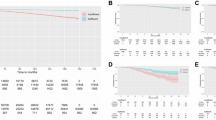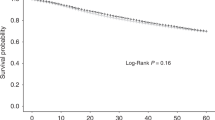Abstract
The annual incidence of prostate cancer more than doubled between 1984 and 1990, increasing from an estimated 76 000–200 000 cases respectively. Part of this increase may have been the result of increased detection. This study utilizes data from an American College of Surgeons Patient Care Evaluation (PCE) study to report on changes in the management of metastatic disease.
Approximately 2000 hospitals were invited to submit data on a standard collection form designed by a multidisciplinary committee of specialists. Data were received from 730 hospitals on 14 716 patients with newly diagnosed cancer of the prostate in 1984, and from 1035 hospitals for 23 214 patients in 1990.
Between 1984 and 1990 there was a decrease in the percentage of reported patients diagnosed with Stage IV disease, falling from 25.3–21.2%. The number of patients receiving a prostate specific antigen (PSA) test increased from 6.3–74.8% and the proportion of abnormal PSA results increased from 82–92.7%. The proportion of patients diagnosed by transurethral resection of the prostate (TURP) and perineal biopsy decreased, while an increase was noted in the proportion of men diagnosed by transrectal biopsy and transrectal ultrasound (TRUS). Treatment by orchiectomy alone increased from 31.8–40.7% of patients, while the administration of exogenous hormone therapy alone declined from 22.3–14.9% of patients. Two and five-year survival rates for the most common forms of therapy were 56.7% and 22.5% respectively for orchiectomy, 57% and 24.6% respectively for exogenous hormone therapy, and 50.3% and 23.5% respectively for no cancer directed therapy. Following a second course of therapy, the two-year survival rate for patients receiving a subsequent orchiectomy was 36.7 vs 17.8% for those receiving secondary exogenous hormone therapy.
The percentage of patients diagnosed with Stage IV disease has decreased while prostate cancer diagnoses are being made more frequently utilizing the PSA test and TRUS biopsies. Hormone treatment remains the most common form of therapy with either orchiectomy or exogenous hormone therapy having higher survival rates than other common treatment modalities.
This is a preview of subscription content, access via your institution
Access options
Subscribe to this journal
Receive 4 print issues and online access
$259.00 per year
only $64.75 per issue
Buy this article
- Purchase on Springer Link
- Instant access to full article PDF
Prices may be subject to local taxes which are calculated during checkout
Similar content being viewed by others
Author information
Authors and Affiliations
Rights and permissions
About this article
Cite this article
Guinan, P., Stewart, A., Fremgen, A. et al. Patterns of care for metastatic carcinoma of the prostate gland: results of the American College of Surgeons’ patient care evaluation study. Prostate Cancer Prostatic Dis 1, 315–320 (1998). https://doi.org/10.1038/sj.pcan.4500259
Received:
Revised:
Accepted:
Published:
Issue Date:
DOI: https://doi.org/10.1038/sj.pcan.4500259



